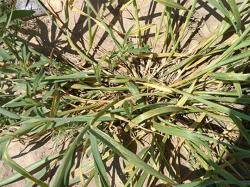Western Kansas Hit By Wheat Streak Mosaic Virus
May 19, 2017 | 2 min to read

While grazing cattle on volunteer wheat may seem like a cost-effective option in a tough farm economy, not controlling volunteer may cost you, and your neighbors, down the line. Volunteer wheat is a host for the wheat curl mite, the transmitter of Wheat Streak Mosaic Virus (WSMV), the disease that is crippling the western Kansas wheat crop.
In addition to WSMV affecting wheat, it's common for plants infected with WSMV to also be infected with High Plains mosaic and triticum mosaic viruses. The symptoms of these diseases are nearly identical, but disease severity is greater when plants are infected by more than one virus. According to K-State Research and Extension Agronomy, six west-central Kansas counties (Greeley, Wichita, Lane, Hamilton, Kearny and Finney) are experiencing extreme distribution of wheat streak mosaic, triticum mosaic and high plains mosaic virus. Many fields in this area are severely diseased and could experience more than 70 percent yield loss, if not a complete loss. The rest of western Kansas is dealing with high distributions of these diseases while the central region is also seeing high and moderate infection levels.
Losses due to WSMV depend on variety, weather, percent of plants infected and the time of infection. Infections that occur in the fall are the most damaging, with yield losses of 50 percent or more. Spring infections may cause losses closer to 20 percent. The first visible symptoms usually pop up in April on the edges of fields near volunteer wheat. Yellow streaking and mosaic patterns on young leaves and stunted tillers are some of the first signs. Symptoms worsen as the weather warms. Leaves on the infected plants turn yellow from the tip down, but usually the leaf veins remain green the longest. This gives the appearance of a striped yellow and green leaf, if the leaf is able to unfurl completely at all.
While there is no chemical treatment for WSMV, there are management options to limit your risk. Controlling volunteer wheat is essential, both for yourself and your neighbors. Volunteer wheat provides a "green bridge" through the summer between successive wheat crops, and that green bridge is the perfect home for wheat curl mites, the only known vector of WSMV. The volunteer wheat must be thoroughly destroyed for no fewer than two weeks in order to eliminate the wheat curl mites. Kansas winds are the preferred mode of transportation for wheat curl mites, so volunteer must be killed within ¼ to ½ mile of a newly planted field.
Another control option is to avoid early planting. It's recommended to wait until after the "fly-free" date for WSMV control. Plant varieties with resistance to the virus or the curl mite. While no variety currently has high resistance to WSMV, many varieties do have a partial resistance. In addition, the Kansas Wheat Commission funded research into developing a trait, WSM3, that is highly resistant to both wheat streak mosaic and triticum mosaic viruses.
Undoubtedly, the best method to control WSMV is controlling the volunteer wheat. Be a good steward, and a good neighbor, when making these management decisions, and you might just be rewarded with a boost of bushels on your next wheat crop.
Source: Kansas Wheat
